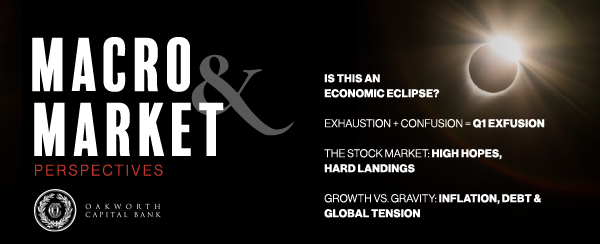- Regardless of who wins the Canadian national elections in late April, relations between the U.S. and its norther neighbor will be frostier than they have been in recent memory.
- At some point, negative consumer sentiment and the better-than-expected economic data will start to converge. Either the former starts to feel better about things or the latter starts to weaken. That or a combination of the two.
- By the end of the 2nd quarter of 2025, the Federal Reserve will have enough data to support more than 50 basis points (0.50% worth of rate cuts for the year. Whether it does so will be a different story.
- Despite some noise from the administration’s tariffs, inflation starts to soften throughout the year. Unfortunately for the U.S. consumer, that doesn’t mean prices are going down. They just won’t be going up as fast.
- Despite all the DOGE related headlines, the Federal government will run a massive deficit during fiscal year 2025. Any cost savings Elon Musk and crew were/are able to find a likely won’t be fully realized until the 2026 fiscal year.
- Thanks to job losses in the federal government, and the jobs that depend on them, the official unemployment rate starts to tick up by the end of the 2nd quarter. It won’t be disastrous. Just enough to make it apparent the labor market is softer than it was.
- The European Union and the United Kingdom prove to be an impediment to a lasting ceasefire in Ukraine. So much so, Washington will seriously consider letting Europe deal with what is ultimately a European problem by itself.
- Gold will continue to shine throughout much of the year, as foreign central banks want an alternative to the U.S. dollar and the U.S. wants an alternative to everything else.
- Despite weaker economic activity, sluggish foreign currency inflows and persistent deficit spending will likely put upward pressure on long-term interest rates. To counter this, the Federal Reserve will likely start, or threaten to start, another quantitative easing program to give “a bid” to the back end of the yield curve. That is a fancy way of saying the Fed will act as a backstop to the bond market.
- The strong performance international equities enjoyed during the 1st quarter will start to evaporate, as investors are reminded of the long-standing challenges: demographic headwinds, fiscal constraints, a burdensome regulatory environment and entrepreneurial sluggishness.
- Residential rental rates will start to show some signs of weakening. The administration’s crackdown on illegal immigration will leave fewer people looking for places to live. This will have a ripple effect throughout the country. However, it will be a slow process.
- The fast-food industry will suffer through a year of turmoil. Franchisees will spend more on kiosks and other forms of automation. They will close underperforming outlets, slash menu options and push back on company promotions. The U.S. consumer is changing its behavior, and the industry is going to have to change with it.
- U.S. stock markets will likely remain volatile throughout the 2nd quarter. Despite the 1st quarter pullback, overall valuations remain elevated by historical standards. Investors will need to see stronger earnings growth for more Fed rate cuts in order to make the markets significantly higher.
This content is part of our quarterly outlook and overview. For more of our view on this quarter’s economic overview, inflation, bonds, equities and allocations, read the latest issue of Macro & Market Perspectives.

The opinions expressed within this report are those of the Investment Committee as of the date published. They are subject to change without notice, and do not necessarily reflect the views of Oakworth Capital Bank, its directors, shareholders or associates.


